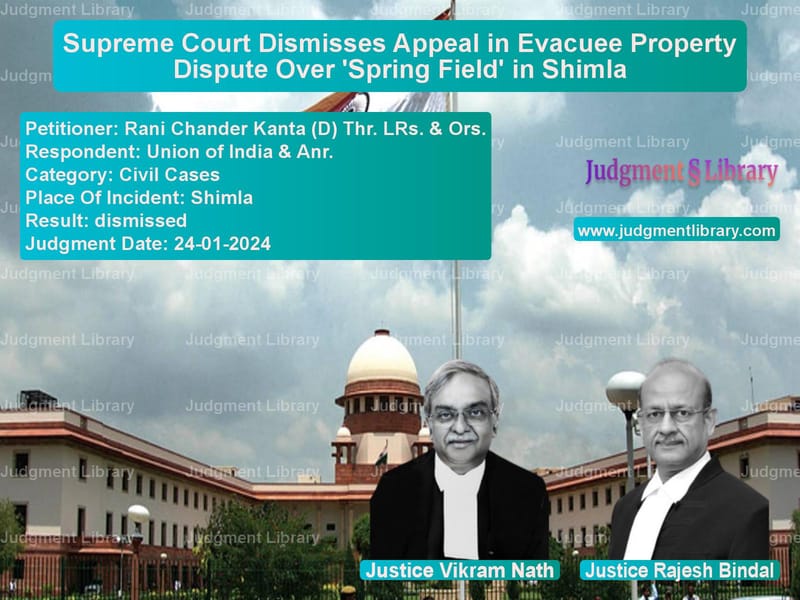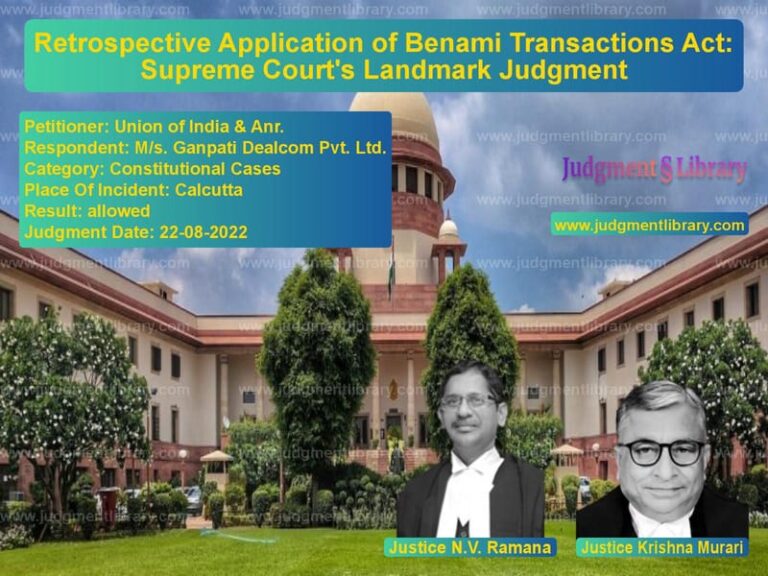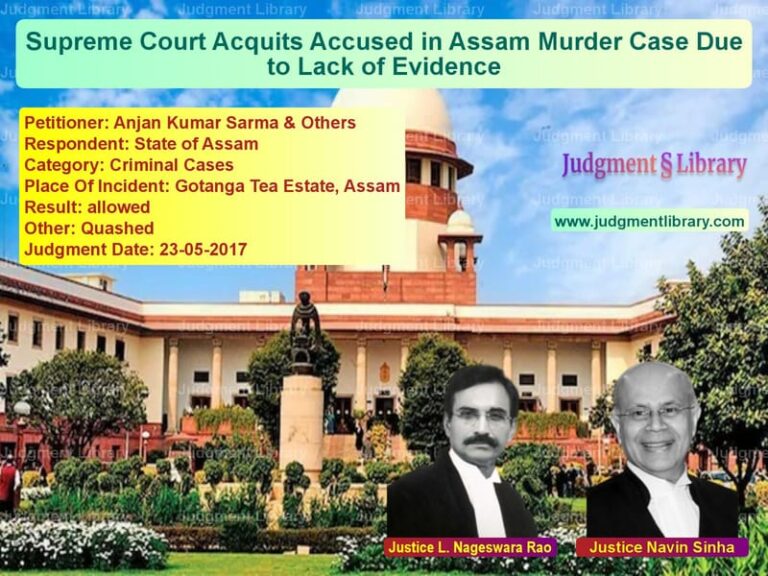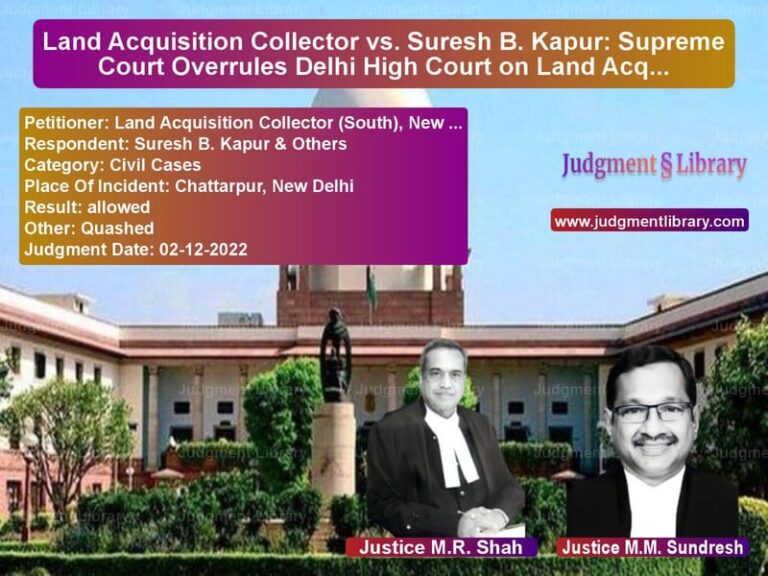Supreme Court Dismisses Appeal in Evacuee Property Dispute Over ‘Spring Field’ in Shimla
The legal dispute over an evacuee property named ‘Spring Field’ in Shimla has been a long-standing battle. The appellants, the legal heirs of Raja Dhian Singh, contested their right to the entire property, arguing that it was sold to their predecessor. However, the Supreme Court dismissed their appeal, reaffirming the decisions of the lower appellate courts and the High Court. This case highlights the complexities involved in evacuee property transactions and the legal implications of administrative decisions made post-partition.
Background of the Case
The dispute traces its origins to the partition of India in 1947 when the original owner, Md. Yahya Khan, migrated to Pakistan, making the property subject to the East Punjab Evacuee’s (Administration of Property) Act, 1947. Raja Dhian Singh, who was also a displaced person, was allotted the property temporarily on an annual rent basis. Later, in 1954, the Rehabilitation Department decided to sell it, offering the first right of purchase to Raja Dhian Singh.
Upon accepting the offer, the property was transferred to him for ₹40,000. A sale certificate and a conveyance deed were issued, but the area mentioned was 2,786 square yards. The appellants later contested that the entire area of 11,435 square yards was intended to be sold.
Legal Issues Involved
- Was the appellants’ claim over the entire 11,435 square yards valid?
- Did the sale certificate and conveyance deed legally transfer only 2,786 square yards?
- Were the later orders transferring additional land to the appellants lawful?
Petitioners’ Arguments
Senior Advocate Mr. Huzefa Ahmadi, representing the appellants, contended that the entire ‘Spring Field’ property was included in the sale. He pointed out that no specific area was mentioned in the tender notice, and his clients had been in possession of the whole land. He further argued that similar properties had been transferred in full to their buyers, making this case a clear instance of discrimination.
The appellants asserted that the tender did not mention any particular area or boundaries, thereby indicating that the entire property was included in the sale. They also referred to the fact that other evacuee properties in similar circumstances had been transferred fully to their buyers.
Respondents’ Counterarguments
The Union of India, through its legal counsel, contended that only 2,786 square yards had been assessed for sale, which was confirmed by valuation records and conveyance deeds. Any additional land included later was due to clerical errors and was not part of the original sale agreement. They argued that major portions of the land were still forest land and not intended for sale.
The respondents provided documentary evidence showing that:
- The valuation for 2,786 square yards was completed before the property was put up for sale.
- The sale certificate and conveyance deed issued clearly mentioned this area.
- Subsequent adjustments in land allocation were unauthorized and unlawful.
Supreme Court’s Observations
The Supreme Court carefully analyzed the evidence and observed:
“Merely with the identity of the property or its number, no title can be passed on any prospective buyer, once a conscious decision had been taken by the authority concerned to sell only a portion thereof and not the entire area.”
The Court highlighted that:
- The valuation for the property was conducted before it was sold.
- The tender notice did not imply that the entire property was up for sale.
- The appellants’ claim was based on incorrect assumptions rather than legal grounds.
It was further noted that after the issuance of the sale certificate in 1976, the appellants initially did not object to the area mentioned. Their first representation came much later, raising questions about the validity of their claim.
Final Judgment
After considering all the arguments and evidence, the Supreme Court ruled against the appellants, dismissing their claims over the additional land. The appeal was dismissed, affirming the decision of the High Court.
“For the reasons mentioned above, we do not find any merit in the present appeal. The same is accordingly dismissed, with no order as to costs.”
Implications of the Judgment
This ruling has far-reaching implications for evacuee property disputes, reinforcing the principle that government authorities must adhere strictly to the terms of sale agreements. It also sets a precedent for similar cases where claimants argue for additional land based on unclear sale documents.
The case reaffirms that mere possession of land does not equate to ownership unless legally documented in sale agreements. The ruling serves as a cautionary tale for buyers of evacuee properties, emphasizing the need for clarity in legal documentation.
Petitioner Name: Rani Chander Kanta (D) Thr. LRs. & Ors..Respondent Name: Union of India & Anr..Judgment By: Justice Vikram Nath, Justice Rajesh Bindal.Place Of Incident: Shimla.Judgment Date: 24-01-2024.
Don’t miss out on the full details! Download the complete judgment in PDF format below and gain valuable insights instantly!
Download Judgment: rani-chander-kanta-(-vs-union-of-india-&-anr-supreme-court-of-india-judgment-dated-24-01-2024.pdf
Directly Download Judgment: Directly download this Judgment
See all petitions in Property Disputes
See all petitions in Contract Disputes
See all petitions in Damages and Compensation
See all petitions in Judgment by Vikram Nath
See all petitions in Judgment by Rajesh Bindal
See all petitions in dismissed
See all petitions in supreme court of India judgments January 2024
See all petitions in 2024 judgments
See all posts in Civil Cases Category
See all allowed petitions in Civil Cases Category
See all Dismissed petitions in Civil Cases Category
See all partially allowed petitions in Civil Cases Category







